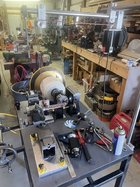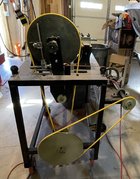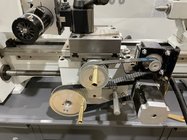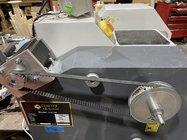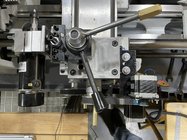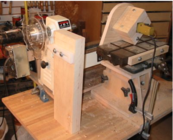Hello all, I just recently joined Ornamental Turners International and noticed the forum has been moved over here. This will be my first post on either so please go easy on me if my forum etiquette is a bit off the mark. I only discovered the Rose Engine a short while back and I've been hooked since. I'm starting to work on a design for a build and I could really use some help. I mainly need a few rough dimensions so I can start doing a sketch or two. I do most of the design work on the fly as I fabricate and machine parts to suit despite all the drawbacks associated with working like that. I'd like a machine that will of course do ornamental wood turning but also be robust enough to experiment with guilloche as well as straight line work in metal. The natural choice is the Lindow Rose Engine, unfortunately buying a turn key machine wouldn't be in the budget until many years after the kids are through college. I don't want to wait 10-15years!
What I'd like to do is build the base machine and use Lindow Rosettes, rubbers, leveling chuck, straight line attachment, cutting frames etc. The list is endless and I can buy pieces as the budget allows. I know most of what I need to make the crossing plate, worm and barrel assembly do what it needs to do with the rocking frame and tower to hold the rubbers. I have no intention of copying the Lindow machine, mine will be much simplified, less precise and based off of materials I already have gathered in my steel rack.
What I am having trouble with is the scale of the machine, I always picture it being much larger that it really is. It would be very helpful to know the dimension from the lower pivot bushing center to center of the 1" main shaft. I'd like to keep that dimension as close to the Lindow as possible in the hopes I'll add the Lindow Hardinge lower mount and a rebuilt Hardinge crosss slide to the machine one day.
The other dimension I was looking for was the main shaft pulley diameter. I haven't worked out the rest of the pulleys yet, that can come latter though. I was also looking for the nominal bore size of the Lindow rosettes so I can get a general idea of the barrel diameter. I'll use the rosettes themselves for final fitting. It would also be helpful to know how much room the straight line attachment takes up when it's bolted to the front face of the "U" frame. The "U" frame will be machined from 3 peices (at least) of cold rolled flat bar stock bolted together, using keyways or dowels for locating. This is the hardest part of the build for me, getting the pieces machined and attached together while holding less than 0.001" clearance between the bronze bushings and 1" main shaft is going to be tricky.
I know I've missed a few things and I'm sure a few more questions will come up as I go. I'd really appreciate any help your able to give and welcome any and all input, good or bad. I know I've really rambled on here and I hope what I wrote makes sense. Thank you for taking the time to read this, I really hope this new forum location brings more like minded people together to share their knowledge!
What I'd like to do is build the base machine and use Lindow Rosettes, rubbers, leveling chuck, straight line attachment, cutting frames etc. The list is endless and I can buy pieces as the budget allows. I know most of what I need to make the crossing plate, worm and barrel assembly do what it needs to do with the rocking frame and tower to hold the rubbers. I have no intention of copying the Lindow machine, mine will be much simplified, less precise and based off of materials I already have gathered in my steel rack.
What I am having trouble with is the scale of the machine, I always picture it being much larger that it really is. It would be very helpful to know the dimension from the lower pivot bushing center to center of the 1" main shaft. I'd like to keep that dimension as close to the Lindow as possible in the hopes I'll add the Lindow Hardinge lower mount and a rebuilt Hardinge crosss slide to the machine one day.
The other dimension I was looking for was the main shaft pulley diameter. I haven't worked out the rest of the pulleys yet, that can come latter though. I was also looking for the nominal bore size of the Lindow rosettes so I can get a general idea of the barrel diameter. I'll use the rosettes themselves for final fitting. It would also be helpful to know how much room the straight line attachment takes up when it's bolted to the front face of the "U" frame. The "U" frame will be machined from 3 peices (at least) of cold rolled flat bar stock bolted together, using keyways or dowels for locating. This is the hardest part of the build for me, getting the pieces machined and attached together while holding less than 0.001" clearance between the bronze bushings and 1" main shaft is going to be tricky.
I know I've missed a few things and I'm sure a few more questions will come up as I go. I'd really appreciate any help your able to give and welcome any and all input, good or bad. I know I've really rambled on here and I hope what I wrote makes sense. Thank you for taking the time to read this, I really hope this new forum location brings more like minded people together to share their knowledge!

